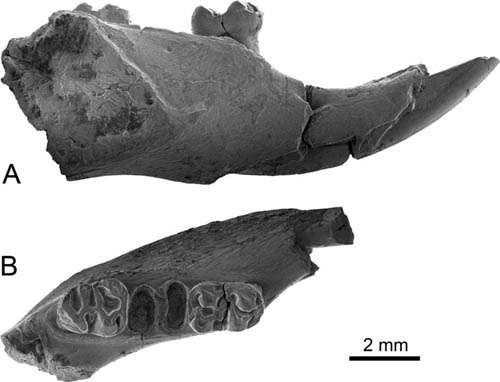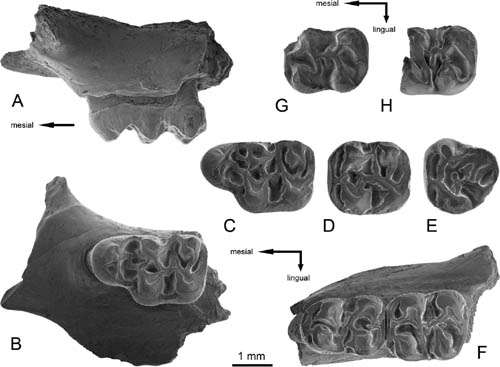New cricetid rodent found from the early Oligocene of Yunnan, China

The cricetids, including extant hamsters, constitute one of the most diverse families of rodents. The Eurasian Paleogene and early Neogene cricetid rodents are very diverse, but the phylogenetic relationships among these cricetids remain unsolved. Discovery of more specimens of these basal cricetids will help to resolve their systematic position. In an article published in Journal of Vertebrate Paleontology 33(1), Drs. Olivier Maridet and NI Xijun, Institute of Vertebrate Paleontology and Paleoanthropology (IVPP), Chinese Academy of Sciences, reported a new early Oligocene cricetid, Paracricetops virgatoincisus, from the Caijiachong locality in Yunnan Province, China. Their phylogenetic analysis including Paracricetops and other early cricetids not only asserts the systematic position of this new cricetid and illuminates the phylogenetic relationships among other cricetids, but also casts new lights on the origin and early radiation of the family Cricetidae.
This new cricetid rodent was discovered at the Caijiachong mammalian fossil locality in Yunnan Province, China in 2008. The Caijiachong locality lies in the north part of the Yuezhou Basin, and is about 20 km southeast of Qujing City.
This new cricetid, Paracricetops virgatoincisus, shows a peculiar combination of characters, such as massive and transversely positioned cusps, crenulated cheek tooth enamel, and a deep fossette enclosed between protocone and paracone. It shows a striking morphology shared with some peculiar Oligocene and early Miocene cricetid rodents, such as Cricetops, Deperetomys, and Meteamys.

In order to decipher the phylogenetic position of Paracricetops virgatoincisus, researchers performed a phylogenetic analysis focusing on the early Eurasian cricetids, particularly the taxa showing morphological similarities to P. virgatoincisus. They selected a newly developed morphological data matrix including 67 characters, two Eocene dipodids, and 35 Eocene, Oligocene, and early Miocene Eurasian cricetid rodents for phylogenetic analysis. The analysis result reveals that Paracricetops and Cricetops are sister groups. Paracricetops, Cricetops, Deperetomys, Meteamys, Selenomys, Melissiodon, Mirrabella, Enginia, Muhsinia, and Aralocricetodon constitute a monophyletic group. This result suggests that these genera should all be grouped in the subfamily Cricetopinae. The subfamily Pappocricetodontinae is a polyphyletic group. Pappocricetodon and Raricricetodon, two basal cricetid genera, are also polyphyletic.
"Our phylogenetic analysis indicates a thorough systematic revision of these basal cricetids is needed. Chronological distribution of Eucricetodontinae, Paracricetodontinae, Pseudocricetodontinae, and Cricetopinae suggests that the establishment of these cricetid clades should be in the late Eocene at least. We therefore deduced that the first diversification and dispersal of the family Cricetidae across Eurasia must have occurred well before the Eocene-Oligocene transition", said study author Olivier Maridet.
The Eocene-Oligocene transition is marked by global climate change. Abrupt global cooling, continental aridification, and expansion of open habitats have been suggested as the main drivers of the diversification of rodents. Although the large change in the distribution and diversity of cricetids seems coincident with the Eocene-Oligocene transition, the dispersal of Asian cricetid rodents into Europe is now known earlier than the date traditionally believed. "Some cricetids such as Eucricetodon and Pseudocricetodon have migrated to eastern Europe in late Eocene. These late Eocene Asian migrants may have served as a stock for European faunal reorganization during the 'Grande Coupure' and the later rapid diversification of Oligocene European cricetids", said study coauthor NI Xijun.
Journal information: Journal of Vertebrate Paleontology





















